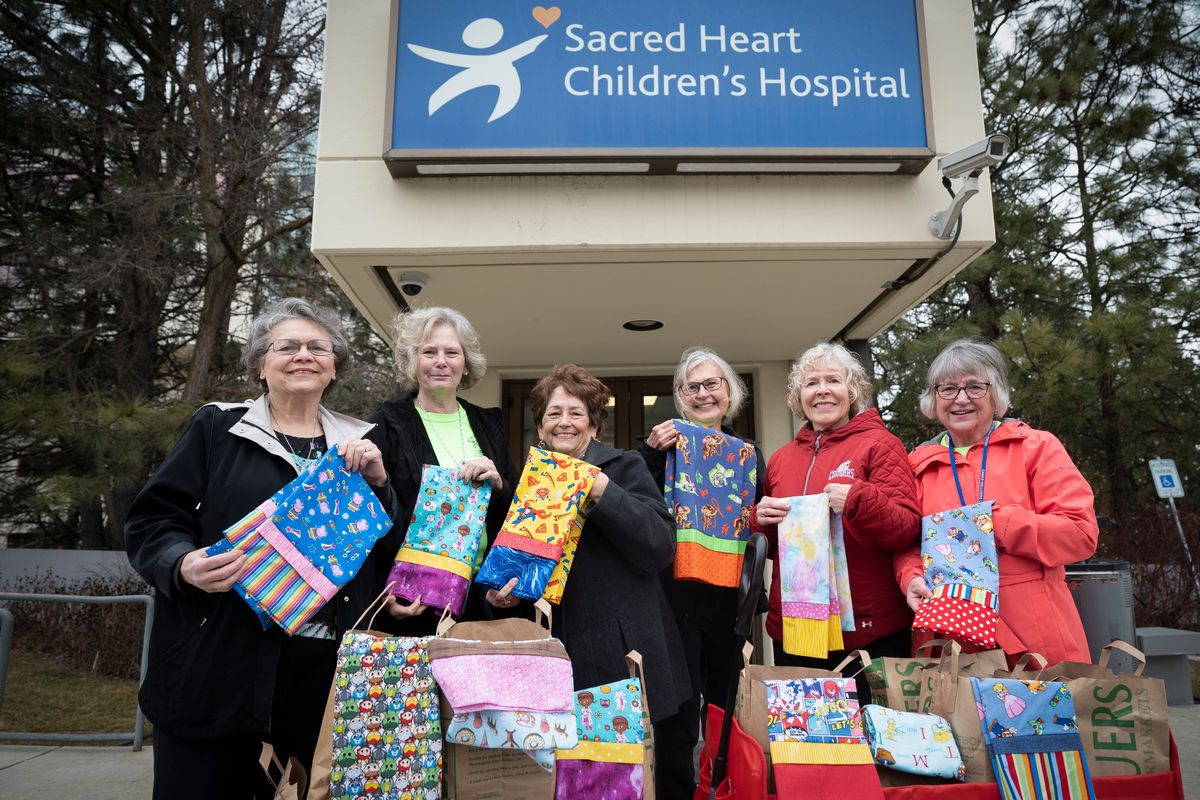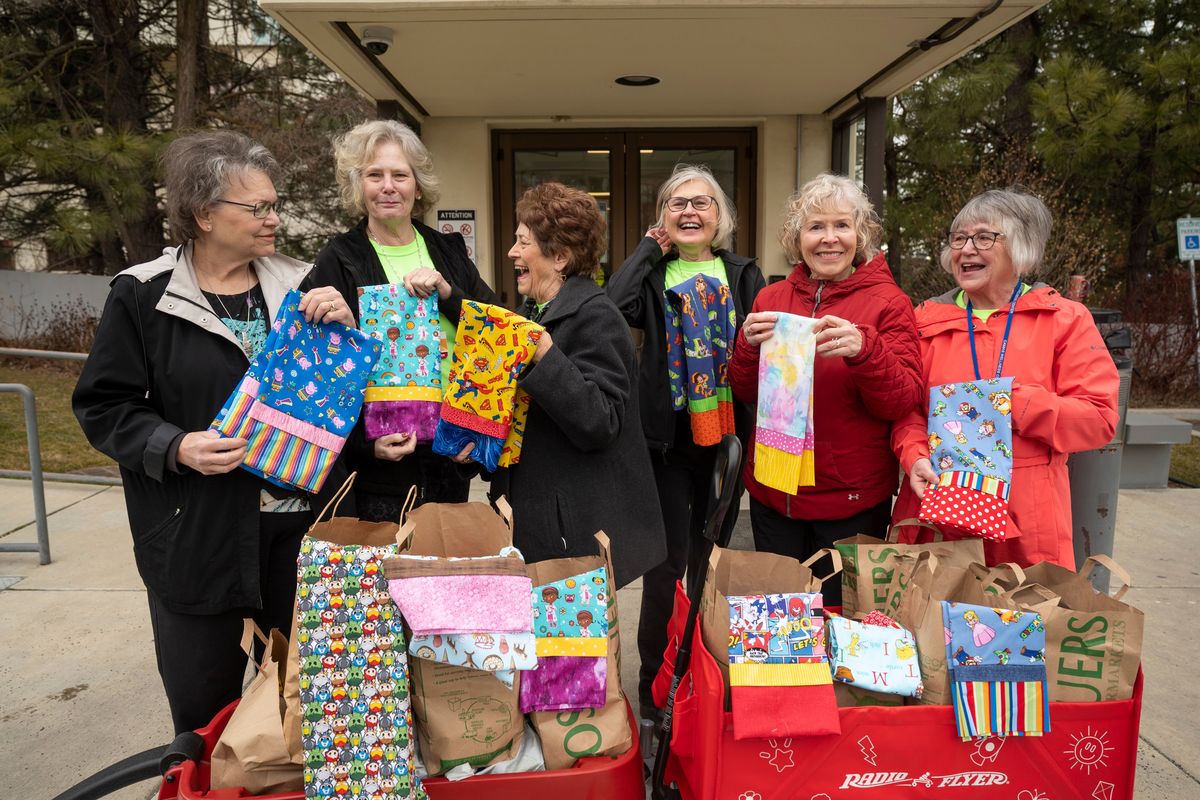‘I’ve gotten more from this than I’ve given’: Local nonprofit chapter that made 15,000 pillowcases for hospitalized kids makes last donation
These women, from left, Betty Higley, Mishia Osborn, Cherry Edwards, Jackie Boardman, Janet Payne and Joyce Beach, laugh while trying to pick a favorite pillow case. They have sewed thousands of colorful, custom pillow cases for the children staying at Providence Sacred Heart Children's Hospital over several years. They are shown outside the hospital Thursday, Feb. 15, 2022, making a delivery of pillow cases. Joyce Beach is the coordinator of the group, which until COVID-19 hit, would sew as a group in one of the children's play rooms inside the hospital. (Jesse Tinsley/The Spokesman-Review)Buy a print of this photo
After a dozen years and more than 15,000 pillowcase donations, a local nonprofit is closing a chapter of bringing joy to children and teens at Providence Sacred Heart Children’s Hospital in some of their toughest moments.
Back in 2010, Joyce Beach began a local chapter of Ryan’s Case for Smiles, a nonprofit that seeks to bring smiles to kids’ faces in hospitals around the country by donating pillowcases that make their hospital rooms feel a bit more like home.
Beach got the idea after spending time with her grandson in a children’s hospital in Michigan. She recalls his face lighting up when a nurse came in and asked if he would like to make his own pillowcase. Beach said he picked a kit for a red pillowcase with Bart Simpson on it. Seeing the way it brought a smile to his face, she decided to make it happen back at home in the Inland Northwest.
On Thursday, Beach dropped off the last batch of pillowcases, which filled two Radio Flyer wagons, to the Providence team.
The core group of local volunteers who have sewn countless pillowcases agreed on Thursday it’s been one heck of a ride.
Tony Schuh, family resource coordinator at Sacred Heart, would take the wagons to laundry services, so they could be washed and sanitized before nurses got to give them out to children.
Schuh said the pillowcases have played an important role in making children and teens comfortable when they get to the hospital. A nurse will ask what they like, from sports teams to characters or cartoons, and then bring them a pillowcase. Sometimes the kids even help make them.
“It decreases the anxiety and fear of being in the hospital,” Schuh said.
Popular pillowcase patterns include “Frozen” or “Peppa Pig,” as well as sports teams like Gonzaga, WSU, the Seahawks and Mariners. Marvel and Harry Potter characters are also patient favorites .
The pillowcases are given out to kids in the children’s hospital, pediatric intensive care unit and oncology department, as well as the emergency department at times .
Pillowcases are not a simple thing to make, at least not when done to the Inland Northwest nonprofit chapter’s standard. While actually sewing the pillowcase with a serger machine might take about ten minutes, the prep work, from ironing, cutting, pinning and putting the kits together, could take hours.
Beach quickly realized she could seek donations from a wide variety of businesses and organizations, and she would turn around and spend that money on fabric. Then she recruited more volunteers to help sew and put the pillowcase kits together.
At its peak, the group would go to the oncology unit in the children’s hospital once a month for a nearly full day of sewing and helping children and teens in the hospital make their own pillowcase. The women would bring their serger sewing machines and help children and teens make their own pillowcases, getting them out of their rooms sometimes or, other times, providing a smile to a kid who was bed-bound with a special delivery.
Doctors and nurses would joke that the committed group of volunteers were experts in “sergery,” and one time the group performed a dance routine, with choreography courtesy of their grandkids, in which they turned Abba’s “Dancing Queen” into “Serger Queens,” with their own lyrics.
Volunteering wasn’t always easy.
Some children would not survive their stay in the hospital, and bonding with families and being a part of their journeys touched many of the volunteers. The nonprofit hosted large volunteer days when dozens of people would show up with sewing machines and work on massive batches of pillowcases.
When Cherry Edwards joined the group, she worked on publicity, getting the group’s mission out there and seeking donations and volunteers.
Beach, who led the nonprofit chapter for 12 years, credited the group of volunteers both at the large events and regular monthly meet-ups for the support and continuation of the effort.
“It took a village to do this,” she said.
The pandemic meant big changes for the group. They had to sew outside the hospital, and for a time the hospital couldn’t take donations at all. Then as guidance shifted, the volunteers were able to use a clubhouse on the hospital campus that wasn’t in use. They couldn’t interact with the kids and families anymore, however.
This month, after a dozen years, the group has decided to retire and shutter their nonprofit chapter. The pandemic, the volunteers’ time, either spent on their own health or families, as well as the rising costs of fabric all led to the decision to move on.
Oftentimes the in-demand fabrics were licensed and, as a result, more expensive . Even still, the supply chain challenges brought on by the pandemic led to increased prices. When she started, Beach said the fabric she used for pillowcases was typically around $5.95 per yard. Now, a yard can cost more than $15. Each pillowcase takes a little over a yard of fabric to make.
On Thursday, the core group of volunteers gathered for the last time to donate the final batch of pillowcases and reminisce about what their work meant.
Edwards said it was bittersweet to drive to the hospital for the last time, and it was emotional to so often be a part of family’s stories, regardless of whether the child recovered .
Ultimately, the group was grateful .
“I think I’ve gotten more from this than I’ve given,” Beach said.


